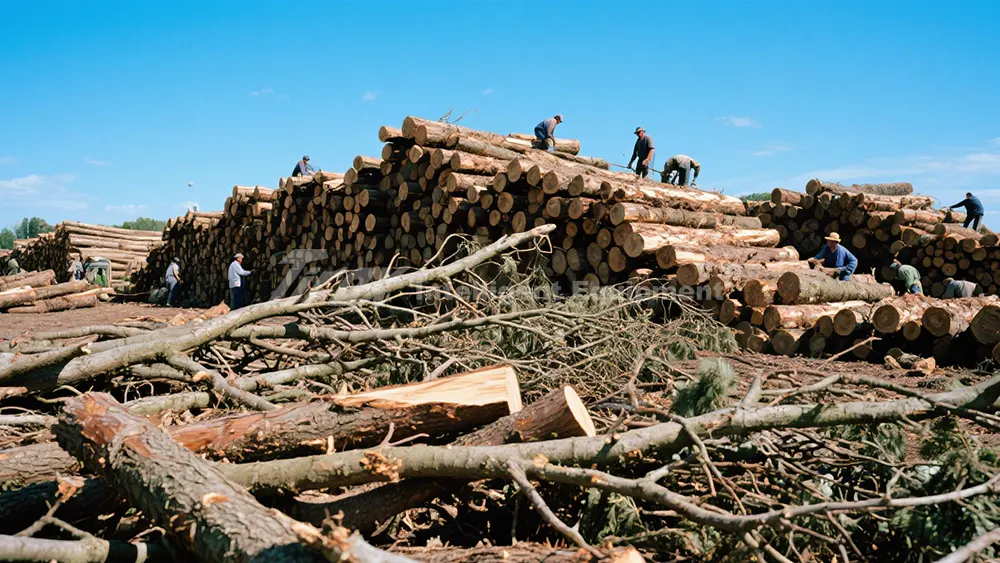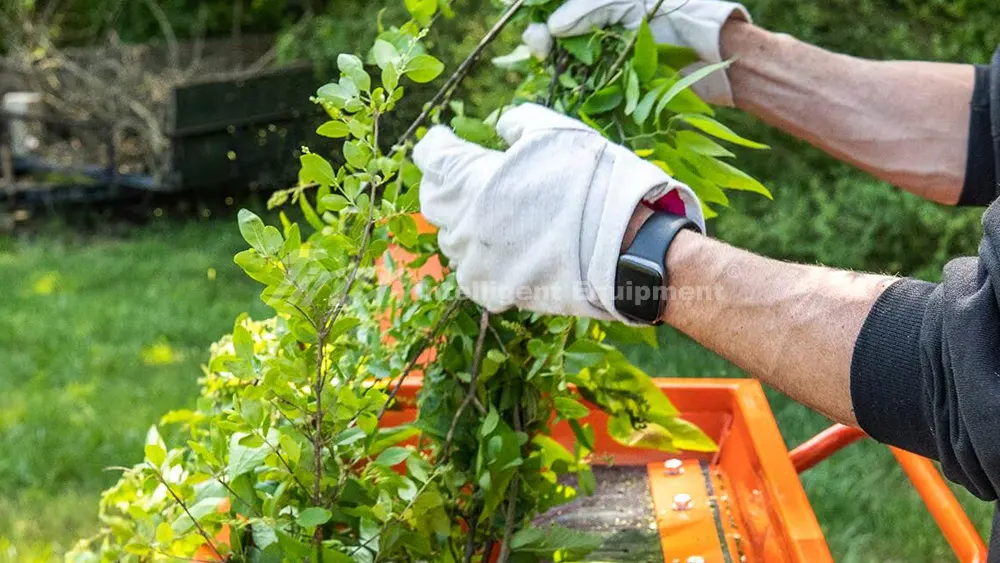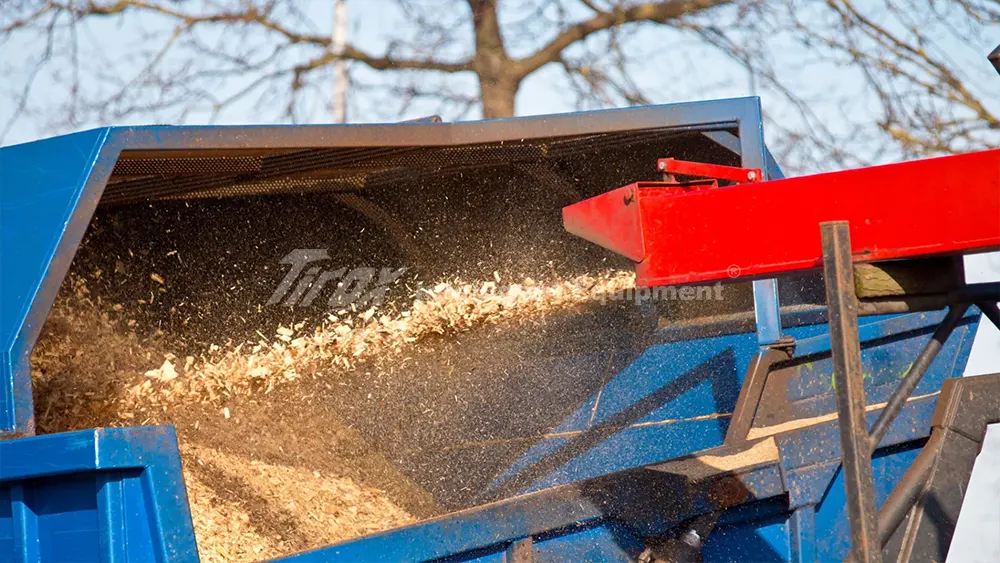You might notice your wood chipper is not cutting as well as it used to. The chips look stringy, and the machine seems to struggle. You are wondering if the blades are the problem and if you can just sharpen them.
Yes, the blades on a wood chipper can and should be sharpened regularly to maintain optimal performance and extend their lifespan. Dull blades negatively affect machine efficiency, cause more wear on the chipper, and can even pose safety risks.
At TIROX, with over 22 years of experience in manufacturing wood chippers, I have seen how critical sharp blades are to a machine’s performance. Just like using a dull knife in the kitchen, a dull chipper blade forces the machine to work harder, producing poor quality chips and putting stress on the engine and other parts. Regularly sharpening the blades is a key part of maintaining your chipper. This not only makes the chipping process more efficient but also ensures user safety and prolongs the life of the machine itself.

Can I sharpen wood chipper blades?
You have noticed a drop in your chipper’s performance, and you suspect the blades. You are wondering if sharpening them is a do-it-yourself task or if it requires a professional.
Yes, you can sharpen wood chipper blades, and it is a necessary part of routine maintenance to ensure optimal chipping performance and prevent machine strain. The process usually involves removing the blades and grinding them to restore their sharp edge.
From my perspective, as a manufacturer, we design our chipper blades to be robust and capable of being sharpened multiple times. Typically, chipper blades are made from hardened steel, meant to withstand the impact and abrasion of cutting wood. When you sharpen them, you are essentially removing a small amount of material from the cutting edge to create a new, sharp angle. This is often done using a specialized blade sharpener or by a professional grinding service. For our disc chippers, the sharpening operation has specific guidelines: you should grind no more than 0.1mm at a time if there are no major nicks, but if there are nicks, you need to grind until they are gone. We also recommend sharpening blades in a group of four at the same time to maintain balance. If the angle can be kept consistent, single blade sharpening is also possible. Over time, after multiple sharpenings, the blade will become too small or thin, and that is when it needs to be replaced entirely.
Blade Sharpening Process and Considerations
| Aspect | Description |
|---|---|
| Why Sharpen? | Dull blades make the chipper work harder, increase fuel consumption, cause more vibration, and produce stringy or uneven chips. Sharp blades ensure efficient cutting, reduce machine stress, and improve chip quality. |
| When to Sharpen? | Signs of dull blades include decreased performance, larger or stringy chips, increased fuel use, more vibration, and louder noise. Visually, the blade edges may appear rounded or chipped. For disc chippers, factors like wood hardness, cleanliness, and blade material affect frequency; for instance, hardwood may require sharpening every 4-5 hours of processing, while softwood might allow 8-10 hours. Dirty wood can reduce this interval significantly, sometimes to 2-3 hours. New blades should be checked after 4-8 hours of initial use. |
| Sharpening Method | Blades are typically removed from the chipper for sharpening. This can be done with a specialized blade sharpener or by a professional grinding service. The goal is to restore the original cutting angle. The grinding amount should ideally be no more than 0.1mm per sharpening pass if there are no significant chips, but if chips exist, grind until they are removed. Maintain an angle tolerance of ±0.5° . |
| Blade Balance | It is important to maintain blade balance, especially when sharpening multiple blades on the same rotor. The weight difference between blades on the same rotor should be less than or equal to 5g. This prevents excessive vibration and wear on the machine. |
| Replacement Thresholds | Blades cannot be sharpened indefinitely. After repeated sharpenings, when the accumulated grinding amount reaches 3-4 cm (total material removed), the blades need to be replaced. This ensures the blade retains sufficient strength and integrity for safe operation. It’s also critical to check blade edges immediately after processing hard fibrous materials like palm, as these can badly affect blade edges. |
Regular and correct sharpening extends blade life and ensures your chipper runs smoothly and safely.
How long do wood chipper blades last?
You are wondering about the lifespan of your chipper blades, trying to plan for maintenance and replacement. You need to know how often you should expect to sharpen or change them.
Wood chipper blades typically last between 25 to 100 operating hours before they need sharpening or replacement. However, this lifespan varies greatly depending on factors such as the type of wood being chipped, the cleanliness of the wood, the blade’s material, and how well the machine is maintained.

As a manufacturer with 22 years of experience at TIROX, I can tell you that blade life varies greatly in the field. For example, if you are chipping softwoods like pine or fir, a blade might last closer to the 100-hour mark. But if you are processing hardwoods like oak or teak, the blades will dull much faster, possibly needing sharpening after just 4-5 hours of operation. The biggest enemy of blade longevity is dirt or foreign objects mixed in with the wood. Even small amounts of sand or grit can significantly accelerate blade wear, sometimes reducing sharpening intervals to 2-3 hours. The material the blade is made from also makes a big difference. Blades made from materials like A8B forged steel offer superior wear resistance and impact strength, lasting longer than those made from 65Si2Mn. Our larger, heavy-duty machines often use more durable blade materials to cope with demanding jobs.
Factors Affecting Wood Chipper Blade Lifespan
| Factor | Impact on Blade Life | TIROX Recommended Sharpening Interval (Disc Chipper Blades) |
|---|---|---|
| Wood Type | Hardwood (e.g., oak, teak): Causes faster dulling. Softwood (e.g., pine, fir): Less wear, longer blade life. | Hardwood: Every 4-5 hours. Softwood: Every 8-10 hours. |
| Wood Cleanliness | Contaminated wood (e.g., with sand, dirt, rocks): The biggest factor in rapid dulling and damage; severely reduces blade life. | Contaminated (with sand/dirt): Every 2-3 hours. |
| Blade Material | High-quality alloys (e.g., A8B forged material): Offer superior wear resistance and impact strength, lasting longer. Lower-grade steels: Wear out faster. | A8B: 15-25 hours (grinding interval), 600-1000 hours (total life). |
| Operating Conditions | Overloading: Puts extra strain on blades and dulls them faster. Machine speed: Higher rotation speeds can increase wear by 30%. | N/A (Smart feed system prevents overload). Higher speeds are inherent to disc chipper design. |
| Maintenance | Regular sharpening and proper machine maintenance prolong blade life [8][14]. Neglecting maintenance shortens it. | Daily visual checks, inspect every 10 hours. |
Regular checks and proper maintenance, as outlined in our guidelines, are key to getting the most life out of your chipper blades.
How do you sharpen shredder blades?
You have a shredder, perhaps a hammer mill, and its performance has dropped. You are wondering how to sharpen its blades, which are different from a wood chipper’s slicing knives.
You do not sharpen shredder blades in the same way you sharpen wood chipper blades. Shredders, especially hammer mills, typically use blunt hammers or flails that are designed to impact and tear material rather than slice it. These hammers are usually replaced or rotated when worn, rather than sharpened.
My experience with various wood processing machines, including hammer mills, confirms this distinction [10][16]. A wood chipper has sharp knives that precisely slice wood against an anvil. When these become dull, you sharpen them to restore that slicing edge. A shredder, specifically a hammer mill, works differently. It uses heavy, rotating hammers that “beat and tear” the material into smaller pieces. Think of it more like smashing something, rather than cleanly cutting it. These hammers are designed for impact. When they wear down, they lose their effectiveness for tearing and crushing. For most hammer mill shredders, the solution is not to sharpen the hammers. Instead, you typically rotate them to use a fresh edge or replace them entirely when all edges are worn. This is part of the regular maintenance for machines like our hammer mills, which are great for processing materials like wood chips, straw, and fruit husks into sawdust or very fine material.
Shredder Blade (Hammer) Maintenance
| Feature | Wood Chipper Blade (Knives) | Shredder Blade (Hammers/Flails) |
|---|---|---|
| Cutting Action | Slicing | Tearing, beating, pulverizing |
| Maintenance | Sharpened repeatedly to restore sharp edge. | Replaced or rotated to present fresh blunt edge. |
| Wear Signs | Rounded or chipped edges, stringy output, increased fuel use. | Rounded or chipped corners, reduced output particle size consistency. |
| Material | Used for rigid wood, branches, logs. | Used for softer garden waste, leaves, biomass, mixed materials. |
| Frequency | Sharpening intervals 2-100 operating hours depending on conditions. | Replacement/rotation frequency depends on wear and material type. |
Always understand the type of cutting mechanism your machine uses to perform correct maintenance [10]. This will optimize its performance and longevity.
Conclusion
Yes, wood chipper blades can be sharpened, and it is a vital part of maintenance to keep your machine efficient. Blade lifespan varies widely due to wood type and cleanliness, but proper sharpening prolongs their use before they need replacement. Shredder blades are typically rotated or replaced, not sharpened.






